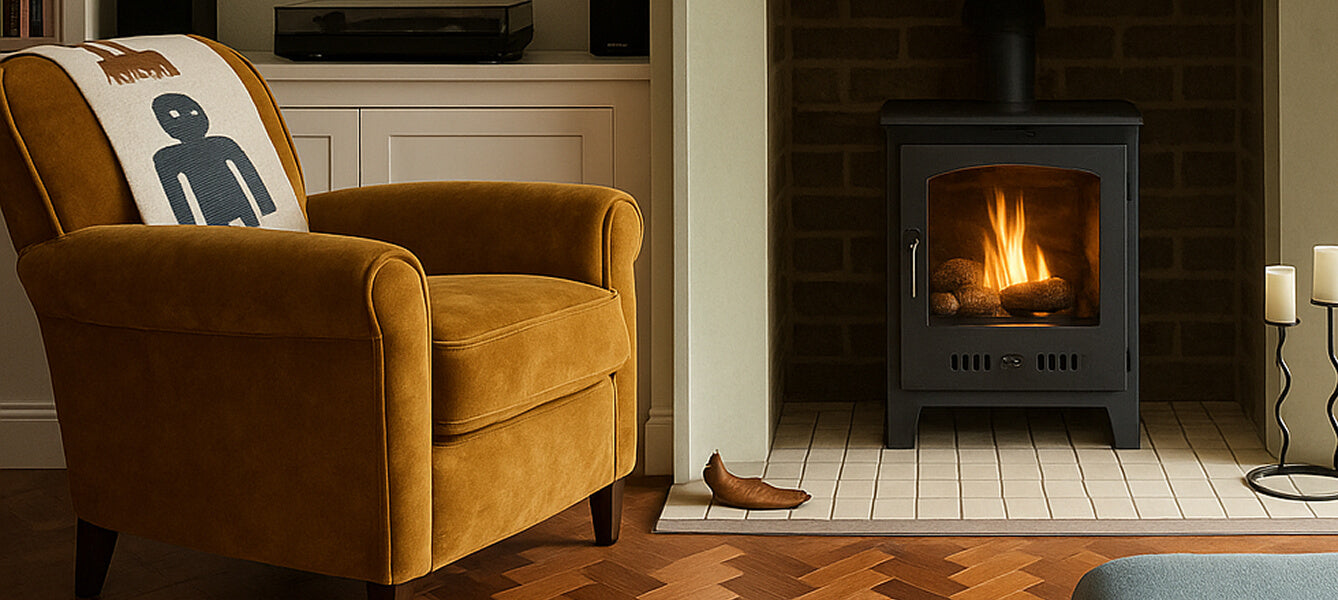
Wood Burners vs Bioethanol Fireplaces: Pros & Cons Guide
Do you love the cosy flicker of a real flame on chilly winter evenings? Maybe you’re planning to install a fireplace but find yourself hesitating over the environmental impact or the mess.
Enter the ultimate question: should you go for a traditional wood burner, or switch to a clean-burning bioethanol fireplace?
Fire has an eternal charm. But let’s be honest: it also comes with its share of smoke, soot, sweeping, and high-maintenance demands.
In this guide, we’ll compare wood burners and bioethanol fireplaces, exploring the pros and cons of both, so you can make the best decision for your home and lifestyle.

Wood Fires - The Traditional Favourite
The Advantages
Most people instinctively lean toward wood-burning fires and with good reason. They’re beautiful, atmospheric, and serve as a bold centrepiece in any room.
- Strong heat output: Wood burners give off a serious amount of heat, ideal for larger spaces.
- Cosy ambience: There’s nothing quite like the crackle and pop of burning logs. The subtle smoky scent adds a nostalgic comfort.
- Style variety: From grand medieval inglenooks to colourful contemporary designs, wood burners span centuries of style.
- Perceived savings: With energy prices rising, many see wood as a more affordable fuel alternative, especially with access to local suppliers.
The Disadvantages
Of course, there’s another side to that roaring fire:
- Heat loss: A significant amount of warmth escapes up the chimney, reducing efficiency.
- Limited fuel choices: Since Ecodesign 2022, only “Ready to Burn” fuels (under 20% moisture) are allowed, no more using damp logs or DIY cuttings.
- Chimney/flue required: You can’t install one just anywhere. No flue? No fire.
- Bulky and space-hungry: Traditional fireplaces can dominate a room, especially in smaller spaces.
- Tricky heat control: Wood fires are usually either full-on or fading fast. Many people open windows to cool the room, not ideal in winter.
Learn more about the latest regulations: read our updated guide to log burner rules and alternatives.

Bioethanol Fireplaces - The Modern Alternative
The Advantages
Bioethanol fireplaces are becoming an increasingly popular choice, especially among eco-conscious homeowners and those living in properties without chimneys.
- Eco-friendly fuel: Bioethanol fuel is made from plants like sugarcane and corn. The CO₂ it releases when burned is reabsorbed by the next crop, making it effectively carbon-neutral.
- No chimney or flue required: This gives you total freedom when it comes to placement. Whether wall-mounted, freestanding or insert, your options are wide open.
- Clean-burning: No smoke, soot, or ash to deal with. Just a beautiful real flame and a clean slate.
- Real flame effect: The flame is real and if you miss the look of logs, you can always accessorise with ceramic logs or pebbles.
- Style flexibility: Choose a rustic log-burner style or a sleek, modern firebox insert. There’s something to suit every aesthetic.
- Safe when used correctly: All our models meet European safety standards and are easy to operate with basic care and ventilation.
Looking for inspiration? Explore our full range of bioethanol fireplaces.

The Disadvantages
While bioethanol fireplaces are easy to use, they're not without limitations:
- Lower heat output: On full burn, most models generate around 3kWh of heat, enough to warm a room comfortably, but not to heat a whole home.
- Fuel costs add up: Expect to pay around £3 per litre of fuel. However, this still works out competitively compared to electric fires.
- The “flueless” look isn’t for everyone: If you love the visual drama of a chimney, you may want to add a false flue (magnetically attached for zero hassle).
- Burn time depends on usage: One litre of fuel gives around 3–5 hours of burn time. Flame size and fuel slider settings will affect this.
Want to enhance the look? Accessorise your fireplace with pebbles, ceramic logs or a magnetic flue.
A Quick Look at Fuel & Cost Efficiency
Let’s do the maths:
- A 12-pack of ImaginFires bioethanol fuel costs £44.99
- That provides approx. 50 hours of burn time at full flame
- Works out at under 90p per hour
And if you burn at a lower setting? You’ll stretch that fuel even further.

Still Not Sure Which One’s for You?
Here’s a side-by-side comparison to help make it clearer:
|
Feature |
Wood Burner |
Bioethanol Fireplace |
|
Heat Output |
High |
Medium (3kWh) |
|
Installation |
Professional required |
DIY-friendly |
|
Chimney/Flue |
Required |
Not needed |
|
Eco Impact |
Moderate |
Very Low |
|
Maintenance |
High |
Minimal |
|
Placement Options |
Limited |
Flexible |
|
Aesthetics |
Classic to contemporary |
Rustic to ultra-modern |
The Verdict
If you're someone who loves the nostalgic ritual of building a fire, tending to the flames, and soaking up serious heat on a frosty evening, then a wood burner may still be your best friend. Just be prepared for the upkeep and the chimney.
But if you’re after a cleaner, greener, more flexible option that offers real flame with less fuss, a bioethanol fireplace could be the smarter choice. It's perfect for smaller homes, apartments, or anywhere a chimney is out of reach.
Still sitting on the fence?
Contact us today: we’re always happy to walk you through your options and help you find your perfect fireplace.
